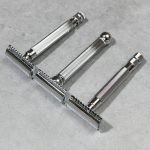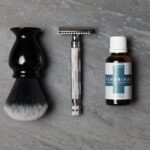With the variety of safety razors on offer and the amount of conflicting advice, choosing my first razor has become rather overwhelming. Can you give me a clear answer on which is the best razor for a beginner?
First, before we go into the issue of finding the “perfect” double-edge safety razor for a new wet-shaver we have to clarify several terms:
- What is a safety razor? The answer is rather simple: any shaver that is not a straight razor (basically a sharp, open blade with a handle) is a safety razor. If the razor has any type of safety feature that is intended to reduce blade exposure to only the tip of the edge, and thus reduce your chances of cutting your throat while shaving, it’s safety razor. Double-edge razors and cartridge type shavers are safety-razors. Shavette razors, since they closely resemble a straight razor, are not. More detailed info on safety razors can be found on… well Wikipedia.
- What is a double-edge razor? A razor that takes double-edge blades.
So, now the logical question is what is a double edge-blade?
A squarish blade that has cutting edges on both of its longitudinal sides. Note: double-edge blades are not the same as twin-blades. The latter are basically cartridges with two parallel blades, one on top of the other.
So to summarize, all double-edge razors are safety razors, but not all safety-razors are double-edge shavers (by now you should have figured out that we use the terms “razor” and “shaver” interchangeably).
Now that we have covered the basic terminology of safety and double-edge razors, we can concentrate on the question that so many new wet-shavers are asking:
Which is the best/perfect razor for a beginner?
An obvious, and rather cheeky, answer would be: whichever works best for you, but this is of little help. However, on a more serious note, we have to stress that most double-edge razors are similar, so your selection might better be influenced by which type of razor you like most from an aesthetic point of view.
For example, most Merkur razors have the same head (the part that holds the blade), hence their shaving behavior is rather similar. The only exceptions are their special models like Slant Bar, a very aggressive razor with a specially designed, slanted head and their adjustable razors (Progress, Futur and Vision).
For all other Merkur models the difference is only in the length, thickness and heft of the handle. Obviously, this part of the shaver does have some influence on how it shaves since, for example, a heavier razor will cut slightly faster, but the difference won’t be huge. Nevertheless, for some the difference between a good and mediocre shave lies in the small details.
Things get even simpler with Edwin Jagger, Muhle and Joris razors, as each brand currently uses only one type of razor head. So, for exemplification purposes, the difference between various E. Jagger shavers rests in the handles; how long, heavy, thick or decorated they are, with the head being identical for all models.
And how do razor heads differ from brand to brand?
There are some sizable differences. Joris and old open-comb Muhle razors tend to be the most aggressive, with aggressiveness being determined by the blade exposure, or the difference between the blade and the blade guard. Merkur razor heads are somewhere in the middle with the E. Jagger and Muhle new models being slightly milder. Weishi are by far the mildest razors to the point of not being recommended for those with normal to thick beards.
In conclusion, while differences exist between different brands and razor models, in the end new wet-shavers aesthetic preferences should pay no small part in choosing a razor.
Related posts: Choosing a Double-Edge Blade, Safety Razors: Adjustable vs. Non-Adjustable.
For a wide selection of double-edge razors, go to Safety Razors on Fendrihan.com





